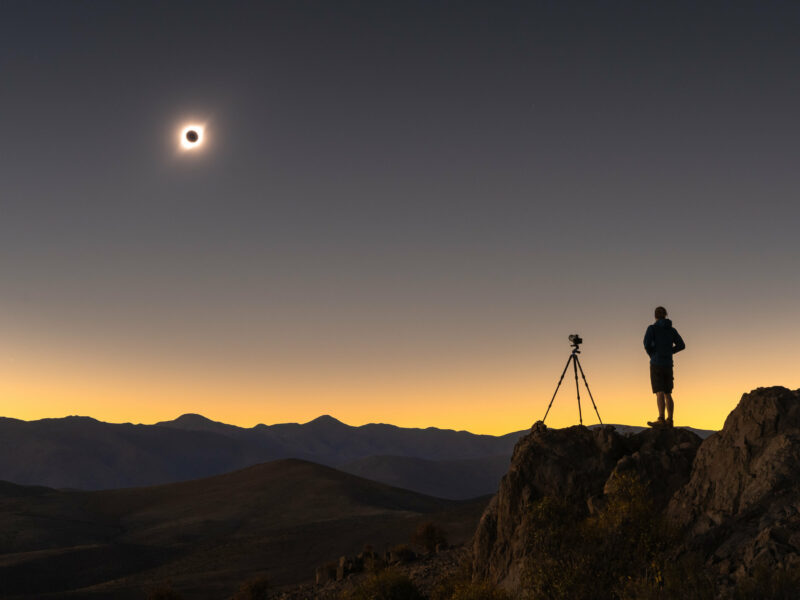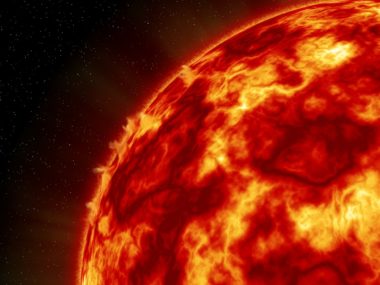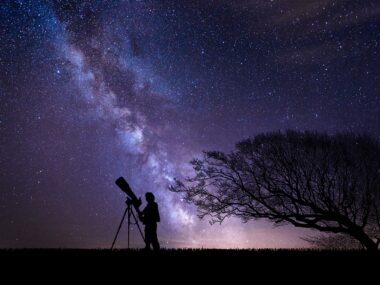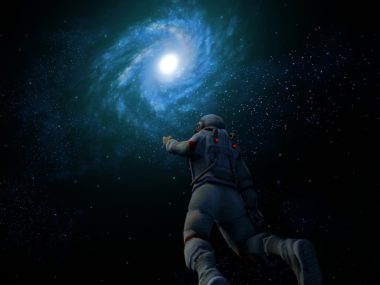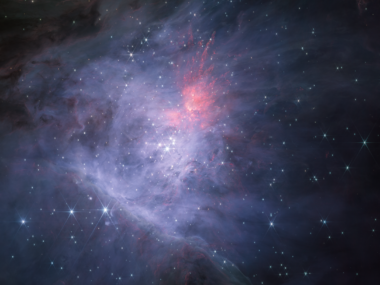Mark your calendars! On April 8th, 2024 (that’s a Monday), the midwestern United States will see an example of the most spectacular astronomical event ever – a total solar eclipse. Perhaps you were fortunate enough to catch the 2017 North American total solar eclipse. If so, you know that you don’t want to miss this event. If not, well, you get another chance to experience one of the most majestic experiences you’ll find in our Solar System from the convenience of your own (continental US) backyard. Your next opportunity won’t be until 2044, so try for it if you can!
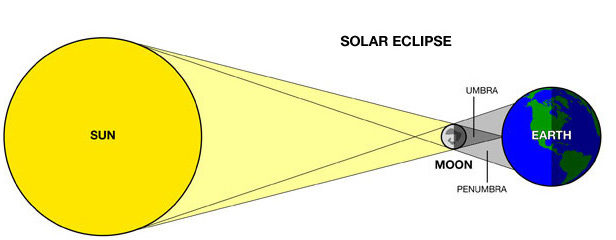
What is a Total Solar Eclipse?
A solar eclipse occurs when the moon comes between the Earth and the Sun. It blocks out part or all of the Sun’s surface from our line of sight. Solar eclipses come in different forms, but by far the most magnificent is the total solar eclipse. During a total solar eclipse, the moon blocks out all of the Sun’s photosphere. The photosphere is the brightest part of the Sun’s surface. When the moon blocks this, we can see the outermost layer of the Sun’s atmosphere, the corona. The fragile white, wistful clouds of the corona against the black of the new moon’s shadow form a startling contrast, the brighter stars come out, and the crickets start chirping – a moment of midnight in the middle of the day. There’s really nothing else like it in the cosmos.
Now, you may know that the new phase of the moon occurs when the moon is between the Sun and the Earth, thus showing us only its dark side. So, why don’t we have total solar eclipses every month?
It turns out that the moon’s orbital plane around the Earth isn’t quite the same as the Earth’s orbital plane around the Sun. There’s a 5º tilt in the moon’s orbital plane compared to the Earth’s. What this means is that while the moon does come between the Earth and Sun every month in its new phase, the Sun and the moon don’t appear in the same place in the sky – usually. However, there are two points of intersection in the orbital paths of the Earth and the moon. If the new moon occurs when the moon is at one of these points (called nodes), then the moon will appear in the exact same place in the sky as the Sun. That’s when we get a solar eclipse.
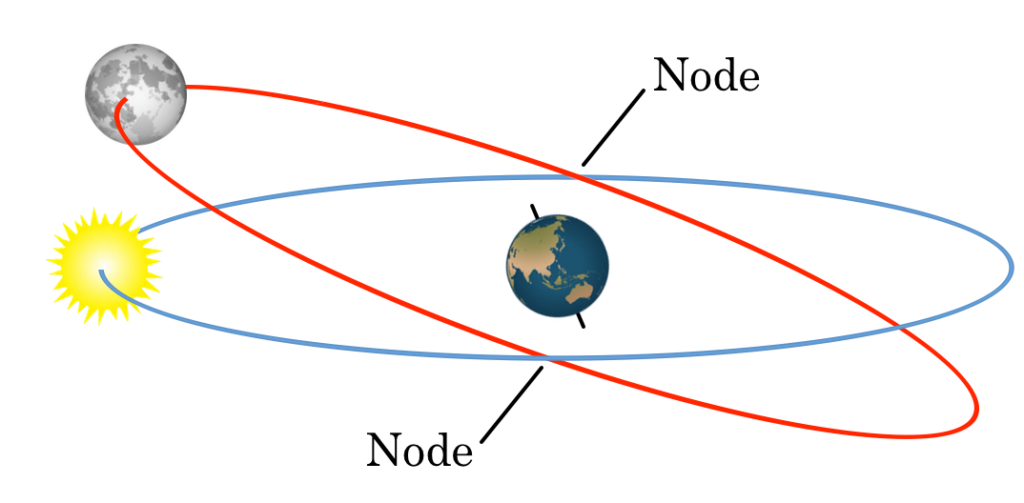
Other Kinds of Solar Eclipses
Then again, not every solar eclipse is a total solar eclipse. If the moon isn’t quite exactly in line with the Sun, we get a partial eclipse. During a partial eclipse, the Sun is never completely covered, but is covered enough to appear as a crescent. This event is only safe to observe with appropriate eyewear or indirect viewing methods.

Another variation on the solar eclipse is due to the fact that the Moon’s orbit around the Earth isn’t perfectly circular. Every month, the moon passes through perigee (closest approach to Earth) and apogee (furthest distance from Earth). If the node of intersection lines up with the Moon’s apogee, then we get an annular eclipse. In these cases, the smaller silhouette of the moon blocks out only the center portion of the Sun’s photosphere. The Sun itself appears as a ring of fire. Again, during an annular eclipse, it is never safe to look directly at the sun.
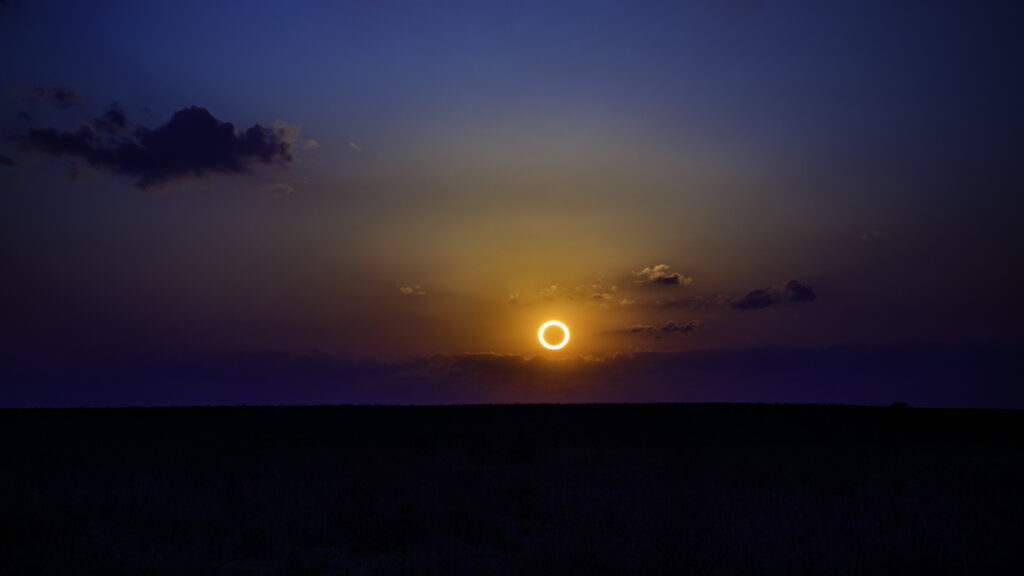
While solar eclipses occur around 2 to 5 times a year, not all these eclipses are total. In addition, the area that sees a solar eclipse is relatively small (the path of totality is around 100 miles across). On average, any given location on Earth will wait centuries before seeing two consecutive total solar eclipses. These factors combine to make the experience of seeing a total solar eclipse relatively rare unless you’re willing to do some serious travel. The most recent total solar eclipses were in southern Chile and Antarctica.
Where (and How) To See It
The April 2024 solar eclipse will take a narrow path about 90 miles wide and move across the midwest. Entering the continental US in central Texas, it will travel northeast to exit the country in Maine. Major cities along the route include Dallas, TX, Little Rock, AR, Cleveland, OH, and Buffalo, NY. The eclipse will occur the afternoon of April 8th, and last around 3 hours from beginning of partiality to end. Duration of totality in the US will range from 4 minutes, 26 seconds on the Mexican border to 3 minutes, 32 seconds near the Canadian border.
One thing you’ll hear anywhere you read about total solar eclipses is the need for eye protection. It is never safe to look at the Sun directly – without eye protection – except during those few minutes of totality. Thus, to fully enjoy a total solar eclipse, you’ll need proper eyewear. Eclipse glasses are the best way to be able to keep an eye on the proceedings as the eclipse unfolds. But if you can’t get your hands on the glasses, there are also methods of indirect viewing. These will let you observe the partial stages of the eclipse without damaging your eyes.
It’s also important to have a good reference of exact times for the beginning and end of totality from your viewing location. Once totality begins, it’s safe to take off your eclipse glasses. In fact, you should take them off, as the corona won’t be bright enough to see through them. But you don’t want to be looking at the Sun when it peeps out from behind the moon at the end of totality.
Significance of Total Solar Eclipses
Incredible beauty and wonder isn’t the only gift given to us through total solar eclipses. They also have played an important role in growing our knowledge of the universe. The unique conditions of a total solar eclipse allow us to study the Sun’s corona with greater detail. But the total solar eclipse has given us insight into far greater mysteries. During the total solar eclipse of 1919, astronomers were able to measure the effect of the Sun’s gravity on light rays emanating from distant stars in the same line of sight. These measurable effects were strong confirmation of Einstein’s recently published theory of General Relativity, which is now an important pillar of modern physics. 1
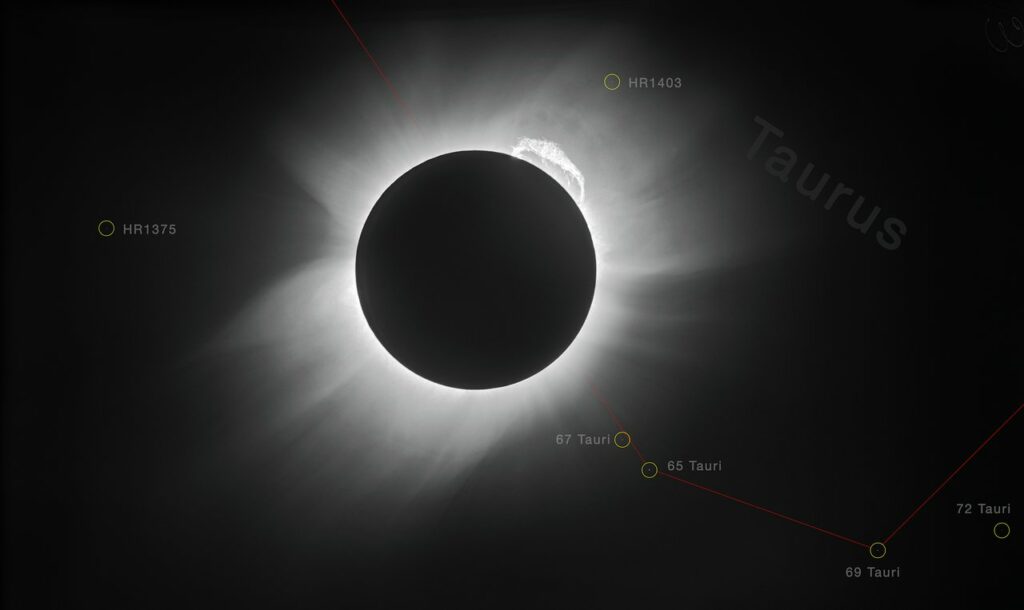
Total solar eclipses are not only rare on Earth – any given location might wait centuries to see two consecutive eclipses – but it also appears that no other planet in the solar system ever witnesses total solar eclipses of such grandeur as seen from Earth.
Oh, What a Wonderful World
For a planet/satellite system to produce a total solar eclipse, the ratio of the satellite’s diameter to that of the Sun has to be close to 1. If it is much less than 1, the satellite will never cover the Sun’s disk. But if it is much more than 1, the eclipse will be overly total, meaning that the satellite completely covers the Sun’s photosphere and corona. This detracts from the beauty and the scientific benefits of a total solar eclipse. Not all total solar eclipses are created equal – an overly total solar eclipse lacks the spectacular visual effect.
For a given planet in the Solar System, we can compare the apparent diameter of the Sun and that planet’s satellites as seen from the planet’s surface. The ratio of the moon’s apparent diameter (as seen from Earth) to that of the Sun is 0.9719. This is why solar eclipses often appear as a “ring of fire” (an annular eclipse). When the moon is at apogee, or the Earth is at perihelion, the moon’s disk doesn’t quite cover the Sun. The resulting effect is that we on Earth are privileged with rare, but strikingly beautiful, total solar eclipses.
Unsurprisingly, the probability of total solar eclipses for a given planet increases with increasing distance from the Sun. This is because as the Sun’s angular diameter decreases with distance, planetary satellites have an easier time blocking its disk. But this same effect also means that total solar eclipses are more likely to be overly total, while the smaller apparent diameter of the Sun greatly diminishes the visual effect. The smaller apparent diameter of the Sun also means these total solar eclipses have a very short duration; in some cases, the total phase of the eclipse would be over in less than a second. It also means total solar eclipses are not nearly as rare as they are on earth, which also diminishes the effect.
An Audience for Majesty
It appears that the Earth is exquisitely positioned for experiencing the optimum display of a majestic solar eclipse, in at least three distinct ways. First, the moon’s apparent diameter compared to the Sun, being almost but not exactly the same size, gives the total solar eclipse a rarity that enhances its awe-inspiring nature. Secondly, the distance of the Earth-Moon system from the Sun gives us an angular size for the Sun that’s large enough to allow us to appreciate the fine details of the Sun’s corona during totality. And, thirdly, the Earth-Moon-Sun system gives us a duration of totality which allows observers to take in and appreciate the experience (up to 7 minutes in some cases). 2
It is certainly thought-provoking to consider that only one planet in the solar system has all the necessary requirements for spectacular solar eclipses is the one planet inhabited by observers who can appreciate them. And indeed, while the experience of a spectacular total solar eclipse is not a prerequisite for life, total solar eclipses enrich the human experience and give us tools to better understand the universe.
So get out there on Monday, April 8th, and see the heavens declaring the glory of God!
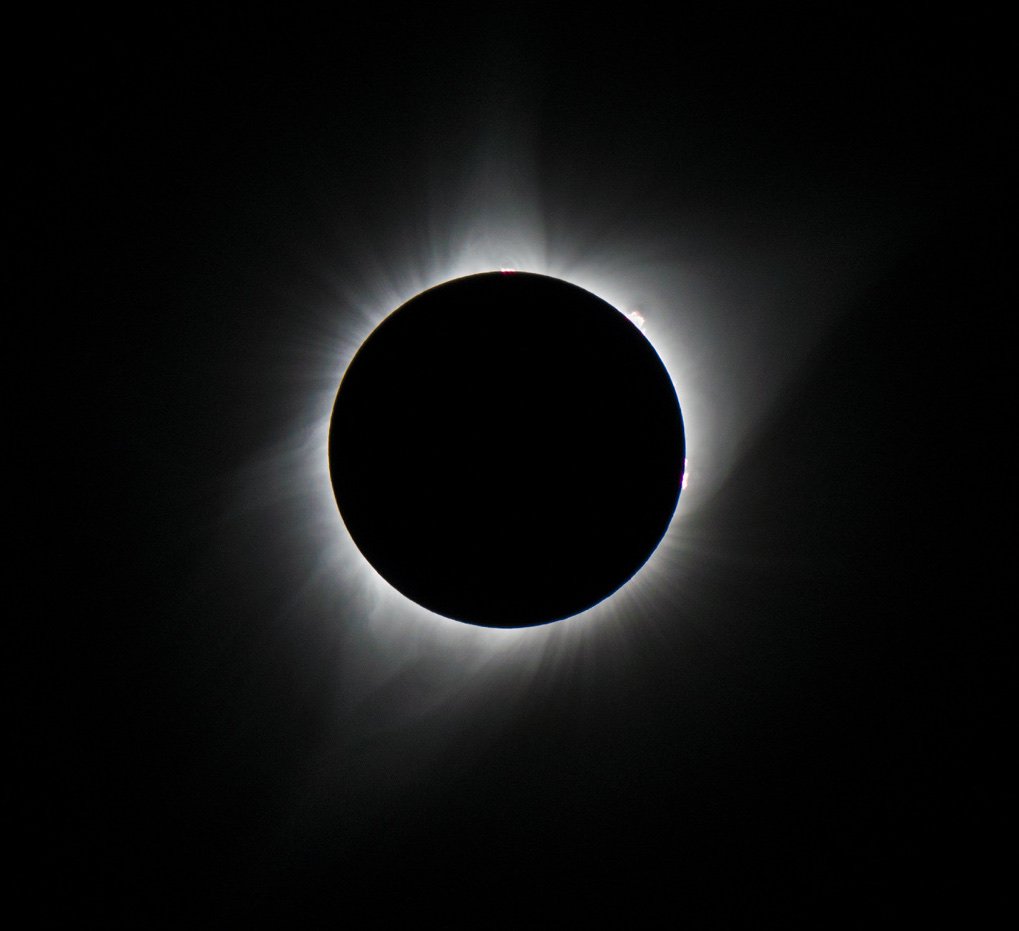
Footnotes
- European Southern Observatory. 2019. Highest resolution image of the 1919 solar eclipse. https://www.eso.org/public/images/potw1926a/ ↩︎
- Faulkner, D. R. 1998. The Angular Size of the Moon and Other Planetary Satellites: An Argument for Design. Creation Research Society Quarterly 35 (1): 23-26. ↩︎

